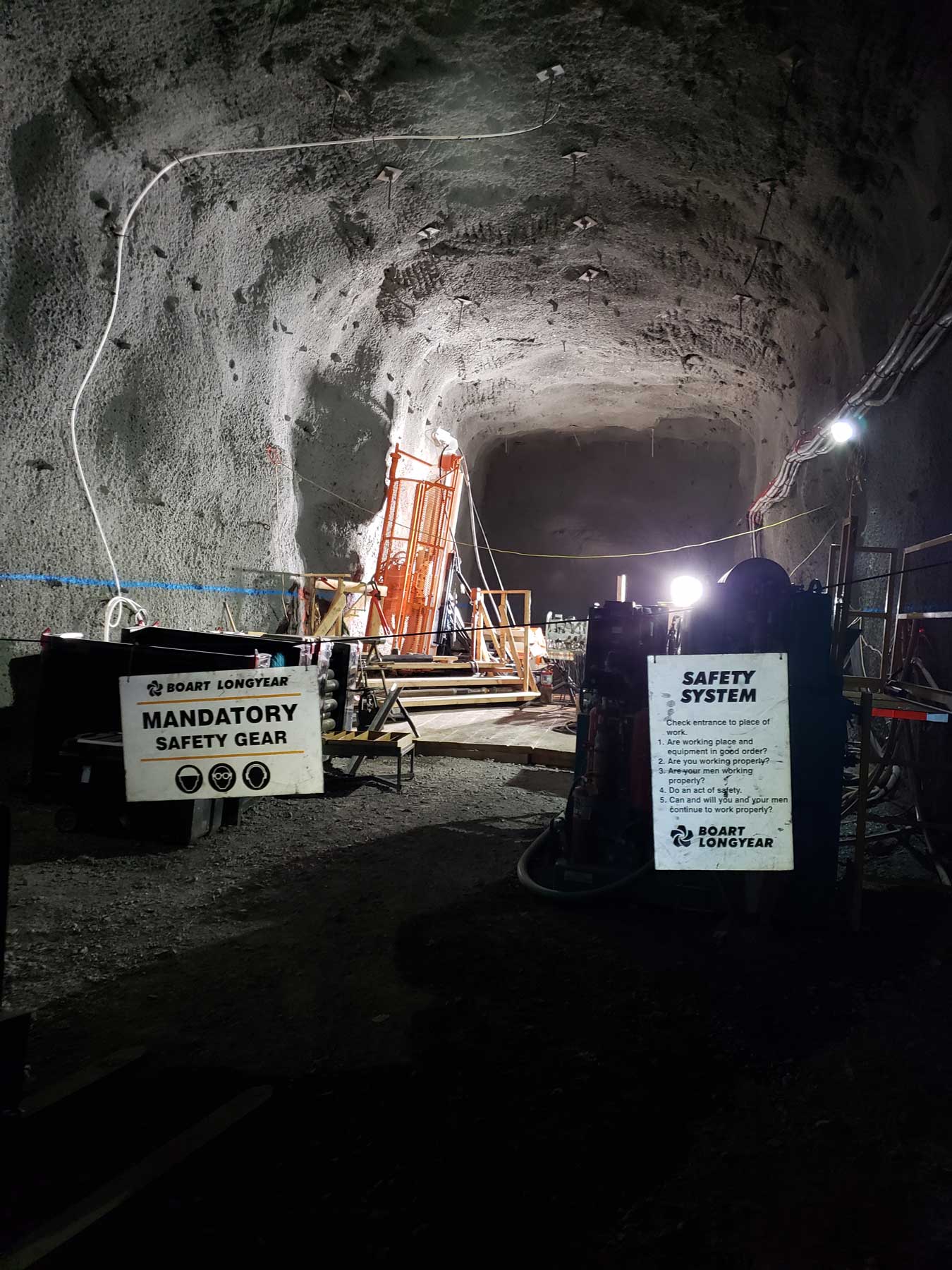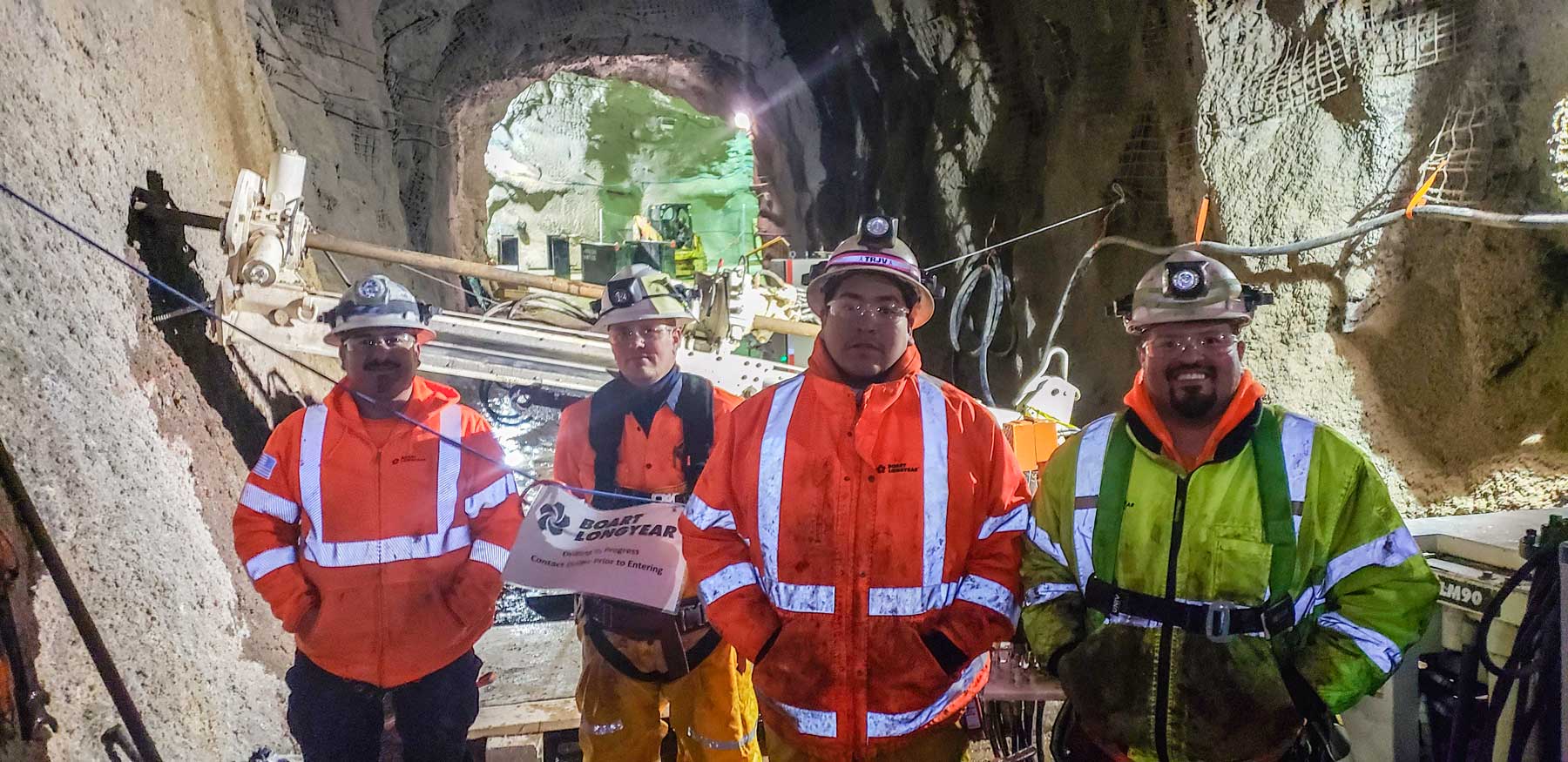EXPLORATION
29 janvier 2020
Explorer les possibilités avec des équipes et des équipements de carottage souterrain ingénieux
Se présenter sur un site minier pour effectuer un carottage au diamant sous contrat ne se déroule pas toujours exactement comme prévu.
Sur un projet particulier, Boart Longyear a mobilisé des plates-formes de carottage souterraines vers une mine d'un client aux États-Unis où la mine était confrontée à un gros problème d'eau qui rendait le carottage d'exploration souterraine impossible à terminer. La mine avait deux puits situés à différents niveaux, l'un au-dessus de l'autre. Le puits le plus profond avait des pompes installées et était prêt à pomper l'eau à la surface. Cependant, le puits supérieur avait été inondé d'eau - où il n'y avait pas de pompes.
Plutôt que d'essayer d'installer des pompes supplémentaires dans le puits supérieur inondé pour évacuer l'eau, Boart Longyear a déplacé leurs plates-formes de carottage souterraines vers le bas pour le puits et foré une série de trous en forme d'éventail dans le puits inondé au-dessus. L'idée a fonctionné, en utilisant efficacement la gravité pour drainer l'eau de l'arbre supérieur vers l'arbre inférieur où les pompes ont ensuite pu déplacer l'excès d'eau vers la surface. La mine a pu poursuivre ses opérations dans le puits supérieur et Boart Longyear a pu commencer le forage d'exploration de carottage au diamant.
Sur un autre projet, la mine était considérée comme sèche. Après le début du carottage souterrain, l'équipage de Boart Longyear a fini par trouver de l'eau - en grande partie, de manière tout à fait inattendue. L'équipage a pu proposer un plan de gestion de l'eau afin que le forage d'exploration puisse être terminé. Après le jointoiement sous pression dans un tubage en col de ciment, un obturateur anti-éruption (BOP - utilisé pour sceller, contrôler et surveiller l'eau pour empêcher les éruptions et la libération incontrôlée d'eau à haute pression) et le bloc de roche ont été installés avec succès, fermant le l'eau. La plupart des cas où cette quantité d'eau est rencontrée jouent tout à fait différemment. Tout le monde a connu, ou connaît quelqu'un qui l'a fait, une situation où un volume d'eau élevé souffle tous vos outils hors du trou, ce qui entraîne un gâchis compliqué.
Forages souterrains forant sur des projets de surface
D'autres exemples de défis inattendus comprennent des solutions créatives utilisant les propres plates-formes souterraines conçues par Boart Longyear en surface. La division Forage souterrain de carottage a mobilisé des appareils de forage jusqu'à un site minier où un retard dans l'exploration souterraine de carottage au diamant a fait tourner les appareils souterrains à la surface. Quelqu'un a vu les plates-formes attendre et a demandé si les plates-formes souterraines inutilisées pouvaient percer des trous à angle plat à la surface. Relevant le défi, les plates-formes de carottage souterraines ont depuis foré ces forages plats à angle plat.
Le site minier a un permis de perturbation de surface limité - ce qui signifie que pour atteindre les formations géologiques en dehors de la zone de son permis de perturbation, la division de carottage souterrain de Boart Longyear exploite des plates-formes souterraines en surface pour forer des trous plats et à angle faible qui font souvent surface. ne peut pas atteindre en raison de leurs grands mâts montés sur camion.
Les plates-formes souterraines peuvent forer à de faibles angles de -40 degrés à plat. Ils forent sous la zone où le client minier n'est pas autorisé à déranger la surface. Cela signifie que le carottage d'exploration peut suivre les veines de minerai sans perturber la surface et forer sous la zone en dehors du permis de perturbation délivré.
Les trous de forage mesurent de 262 à 2700 pieds (792,48 à 822,96 m) à un angle de -40 à -12 degrés. Boart Longyear possède l'outillage et l'expertise pour ce type de forage, mais n'a pas été en mesure d'accomplir le travail avec des plates-formes de surface, car lorsqu'il est installé à plat, vous allez être à 12 pi (3,66 m) du sol parce que le mât est bien en place sur un camion. Avec les plates-formes souterraines, une plate-forme de travail ou un pont a été construit, ce qui a permis à l'équipe de travailler près d'eux.
Une flotte polyvalente et unique
le Division de carottage souterrain de Boart Longyear Drilling Services aux États-Unis, toutes les plates-formes LM ™ et MDR conçues et fabriquées par Boart Longyear sont exploitées. La série LM de plates-formes comporte des composants facilement interchangeables, permettant des contraintes d'espace sans sacrifier les exigences de profondeur. Ces plates-formes de carottage modulaires offrent un accès plus facile dans les espaces souterrains étroits et une mobilité pour des déplacements plus faciles d'un trou à l'autre ou d'un arbre à l'autre. L'outillage breveté de Boart Longyear offre des trous de remontée plus sûrs et plus efficaces à n'importe quel angle.
Les plates-formes de carottage souterraines de la flotte des Services de forage sont modifiées et personnalisées, par rapport aux plates-formes de carottage souterraines Boart Longyear disponibles dans le commerce. Par exemple, le LM ™ 90 est gonflé avec un moteur de 150 chevaux au lieu du moteur typique de 90 chevaux et comprend des modifications supplémentaires pour augmenter la capacité de profondeur et la taille du noyau.
La division Carottage souterrain des Services de forage possède l'expérience et l'expertise technique pour forer des galeries d'assèchement, des forages géotechniques, des investigations de tunnels, des services d'injection de coulis et des forages de services publics. La division possède également de l'expérience en forage surestimé pour mesurer la contrainte in situ. Le forage de surimpression consiste à percer un trou en profondeur avec un foret de petit diamètre EX ou AX, à placer une sonde pour mesurer les données de réponse à la déformation, puis à utiliser une résine spéciale pour coller la sonde en place. Après avoir foré un noyau de plus grand diamètre pour récupérer la sonde, l'échantillon de surestimation et la sonde sont utilisés pour tester sous contrainte la formation rocheuse afin de planifier le support au sol. Cette méthode est souvent utilisée dans les tunnels horizontaux et les puits verticaux pour mesurer la quantité de stress que la roche peut supporter.
Forage horizontal pour l'assèchement
Une autre application unique pour les plates-formes et les équipes souterraines est le forage en surface dans de hauts murs à des fins d'assèchement. Des trous de forage plats à horizontaux - de 10 degrés à 10 degrés vers le bas - peuvent être utilisés pour créer des trous de drainage auto-drainants dans les murs hauts. Le jointoiement sous pression dans un boîtier de col en ciment empêche le trou de s'effondrer et peut être utilisé avec une vanne BOP au cas où le client minier voudrait fermer l'eau dans la formation rocheuse.
Pour maintenir l'intégrité du trou, l'installation de chlorure de polyvinyle fendu (PVC) empêche le trou de s'effondrer. Si vous traversez une zone cassée, lorsque l'eau commence à couler, le trou peut se combler après quelques mois. Le PVC maintient le trou ouvert et l'eau coule.
L'avantage d'utiliser des plates-formes souterraines pour ce type de forage est la différence entre les grandes plates-formes rotatives qui produisent des échantillons de copeaux et utilisent une rotation par minute (tr / min) et un couple plus élevés, tandis qu'une plate-forme de carottage fonctionne à des régimes plus élevés et à moins de couple. Les plates-formes de carottage souterraines à entraînement par mandrin forent plus lentement, plus droit et plus profondément et collectent le noyau pour une analyse plus approfondie.
Les géologues peuvent utiliser des carottes de forage horizontal dans un haut mur pour rechercher des fractures, des failles et l'oxydation (pour identifier les zones aquifères). Ils peuvent également être identifiés dans des échantillons de copeaux à l'aide de plates-formes de forage rotatives, mais il est plus difficile de les voir de cette façon. Un carottage fournit une meilleure vue physique de la formation rocheuse. Le forage de hauts murs avec des plates-formes de carottage souterraines atteint deux objectifs avec un seul trou de forage - la déshydratation et l'obtention d'échantillons de carottes pour analyser les fractures, les défauts et l'oxydation.
LM ™ 90 avec cadre d'alimentation personnalisé. Des foreurs experts de gauche à droite: John Sanchez, Jimmie Maggard, Marcus Woody et Sal Renteria.
Les vrais héros
Qu'il s'agisse d'un projet de carottage souterrain ou d'une application de surface pour des plates-formes de carottage souterrain, les équipes de forage sont les véritables héros de Boart Longyear. Ils ont des ressources (mondiales) étendues pour trouver des solutions uniques et inventives pour des défis de forage complexes, techniques et parfois immenses et ils n'ont pas peur de poser des questions.
Plus qu'une simple attitude positive, une grande éthique de travail, des compétences diverses, une vaste expérience, des connaissances techniques et un engagement envers la sécurité et le succès de chaque client, ils font le travail. Les foreurs, les aides-foreurs, les soudeurs, les mécaniciens, les superviseurs et les autres membres du personnel de soutien se déplacent pour travailler dans des endroits éloignés, dans toutes sortes de conditions météorologiques, de climats et d'altitudes difficiles, tout en passant du temps prolongé loin de leur famille. Le travail est pénible, implique une formation approfondie et nécessite toute leur attention pour des raisons de sécurité.
Chez Boart Longyear, il est de la responsabilité de chacun de travailler en toute sécurité.
Denis Despres, chef de l'exploitation
Ces vrais héros ont tous contribué à la dernière réalisation de Boart Longyear en matière de sécurité, à savoir 10 millions d'heures de travail et un an sans blessure avec arrêt. Un grand bravo à toutes les équipes de forage et au personnel de soutien pour cette réalisation à l'échelle de l'entreprise! Denis Despres, Chief Operating Officer, a déclaré: "Au niveau du site, nous apprécions les procédures quotidiennes issues de réunions d'information pré-démarrage standardisées qui se concentrent sur les tâches quotidiennes et les dangers et risques associés, notre système de gestion des données en ligne, y compris l'application mobile du système, et l'évaluation quotidienne des risques au niveau de l'équipe et sur le terrain. Chez Boart Longyear, il est de la responsabilité de chacun de travailler en toute sécurité. "
Publié à l'origine dans Numéro 11 de Coring Magazine, novembre 2019
INSCRIVEZ-VOUS AU INSITE DIGEST
Inscrivez-vous au bulletin mensuel INSITE Digest pour recevoir des articles comme celui-ci et plus.






